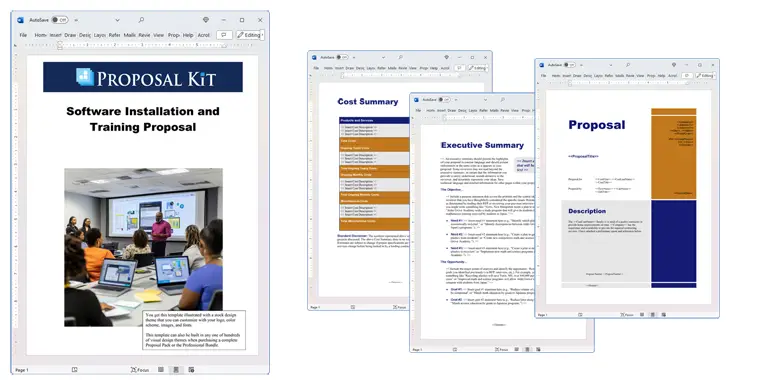How to write your Software Installation and Training Proposal
We include this 24 page layout with every Proposal Pack. If you want this template to have a different visual design theme than the one illustrated here, purchase any Proposal Pack design and create this template using the purchased design theme. This template is included in every Proposal Pack. If you get a Proposal Pack or the Professional, you can also make any variation of this template with different chapters to suit your needs.
We typically include more chapters in the templates than most people will need to give everyone more variety in the chapters they may need. You can trim down a long template by removing pages you do not need or combining multiple chapter topics into one page.
 DOWNLOADABLE, ONE-TIME COST, NO SUBSCRIPTION FEES
DOWNLOADABLE, ONE-TIME COST, NO SUBSCRIPTION FEESYou can also create countless variations of this document to suit your needs using the included library of 2200+ chapters if ordering a Proposal Pack or Professional.
 What Our Clients Say
What Our Clients SayThanks for all your help. I have made the changes and am about halfway through creating the documents for my first proposal. It’s coming along nicely so far!"
InfiniMed
Related Article
Related Video
Related Templates
- Software Beta Testing Project Proposal
- Software System Testing Project Proposal
- Network Software Installation Proposal
- Software Automation Proposal
- Small Business Web Site Project Proposal
- Cloud Computing Services Proposal
- Software Licensing Sales Proposal
- Prescription Monitoring Software Proposal
- Training Services for Software Proposal
- IT Disaster Recovery Services Proposal
- CD-ROM Development Proposal
- Multilingual Web Site and DVD Proposal
- Large Web Site and CD-ROM Project
- Software and Hardware System Proposal
- Software as a Service (SAAS) Proposal
- Custom Software Development Proposal
- Defense Contracting Intelligence System Proposal
- Mobile App Software Development Proposal
- Sales and Inventory System Development Proposal
- Web Site Creation and Software Integration Project
- Micro Web Site Project Proposal
- IT Equipment Maintenance and Repair Services Proposal
- Replacing Legacy Computer Systems Proposal
- Training Plan
- iOS App Development Proposal Template
- Mental Health Communication and Tracking App Proposal
- EMV Chip and Pin Migration Proposal
- Training for Skills Development Proposal
- Home Assistant Artificial Intelligence Project Proposal
- Sales Training Proposal Template
- Network Cabling Proposal
- Specialized Training Educational Proposal
- Training Program Curriculum Innovation Proposal
- Android App Development Proposal Template
- ERP (Enterprise Resource Planning) System Proposal
- FinTech System Integration Proposal Template
- Corporate Training Services Proposal Template
- App Development Proposal Template
- IT Operations Finance Banking Proposal Template
- Training Services Proposal
- Mobile App Development Proposal Template
What's the Best Way to Write Your Software Installation and Training Proposal?
When tasked with writing a software training proposal, you need a proven solution that ensures precision, professionalism, and persuasiveness. The Proposal Kit template and software package is designed to streamline this process for you. With a comprehensive line item quoting database system, Proposal Kit helps you generate accurate cost summaries, quotes, estimates, and budgets, integral to any software system proposal.
Do you need to write such a proposal? If so, Proposal Kit is designed for you.
What Types of Projects Are Software Installation and Training Proposals Written For?
Software installation and training projects come in many forms, and proposals are often required to secure these contracts. Here's a list of situations where these proposals are used:
- Implementing a new enterprise resource planning (ERP) system.
- Installing a customer relationship management (CRM) platform.
- Deploying a new accounting software.
- Setting up a cloud-based storage system.
- Upgrading cybersecurity protocols.
- Implementing a data analytics platform.
- Migrating legacy systems to modern platforms.
- Automating HR processes with software.
- Integrating IoT devices within an organization.
- Setting up remote work collaboration tools.
- Deploying an e-commerce platform.
- Establishing a digital marketing automation system.
- Launching a content management system (CMS).
- Implementing a learning management system (LMS).
- Setting up virtual reality training modules.
- Deploying AI-driven chatbots for customer service.
- Installing a new inventory management system.
- Launching a software-as-a-service (SaaS) application.
- Implementing a blockchain-based security system.
- Deploying a video conferencing solution.
Chapters this template is built with
There is no one-size-fits-all premade template suitable for all software installation and training projects. This is why Proposal Kit allows for the creation of custom variations of templates to suit any circumstance. Below is a starting point of chapters you can customize using Proposal Kit's extensive library of thousands of templates and its Wizard software.
Cover Letter
The cover letter serves as the introduction to your proposal, setting the tone and summarizing the purpose. In a software training proposal, this document should briefly introduce your company, the specific software solution offered, and express your enthusiasm to partner with the client. It's a Word format document designed to capture your client's attention and convey professionalism, setting expectations for the detailed proposal ahead.
Executive Summary
This section provides a snapshot of your entire proposal, highlighting how your software solution and training services will meet the client's needs. In a software installation context, it should succinctly outline the key benefits of your software, the primary objectives of the installation project, and the expected impact on the client's operations, ensuring the decision-makers understand the value proposition.
Cost Summary
The cost summary breaks down the financial topics of the proposal, providing clear estimates and budgets aided by Proposal Kit's quoting system. This section should include detailed line items for software licenses, installation services, training sessions, and any ongoing support costs, ensuring the client can easily assess the financial investment required.
Needs Assessment
This chapter identifies the specific needs of the client, ensuring that the proposed software system aligns perfectly with their requirements. It should include an analysis of the client's current systems, any pain points they are experiencing, and how the new software addresses these issues, thus demonstrating a thorough understanding of the client's unique situation.
Goals and Objectives
Here, you outline the intended outcomes of the project, providing a clear roadmap of what the proposal aims to achieve. Specific goals such as improving operational efficiency, reducing costs, or enabling better data analytics should be highlighted, giving the client a clear picture of the benefits and success criteria of the project.
Project Deliverables
This section details what the client can expect to receive, including timelines and deliverables related to software installation and training. It should outline all phases of the project, from initial consultation to final training, and include key milestones and deadlines, ensuring the client understands the scope and schedule of the project.
Testing Plan
A comprehensive testing plan ensures that the software operates smoothly and meets all specified requirements. This section should include details on the types of tests to be conducted, such as functional, integration, and user acceptance testing, as well as the timeline for these activities, ensuring the client that the software will meet their standards prior to full deployment.
Training Plan
This document outlines how the client's staff will be trained to use the new software system. It should include the format of the training (e.g., workshops, online modules), the duration, the key topics covered, and the expected outcomes, ensuring the client that their team will be fully prepared to leverage the new system.
Configuration
In this section, you describe how the software system will be configured to meet the client's specific needs and settings. It should detail any customization options available, the process for implementing these configurations, and how they align with the client's goals, ensuring the software is tailored to enhance their operations.
Installation Details
Details of the installation process are provided here, explaining the step-by-step implementation of the software system. It should cover pre-installation preparations, onsite and remote installation procedures, and any required downtime, ensuring the client is aware of how the installation will impact their daily operations.
Hardware and Software
This chapter lists the hardware and software components required for the successful implementation of the project. It should specify any additional hardware needed, compatibility requirements, and software dependencies, ensuring the client has a comprehensive understanding of what is necessary to support the new system.
Evaluation
The evaluation section discusses how the effectiveness of the software will be measured post-installation. It should include metrics for success, such as performance improvements, user satisfaction, and return on investment, providing a framework for assessing whether the project objectives have been met.
System Requirements
Here, you define the technical requirements needed for the software installation to work seamlessly. It should list minimum and recommended specifications for hardware, operating systems, network infrastructure, and other technical prerequisites, ensuring the client's environment is prepared for the new software.
Test Requirements
This section specifies the testing criteria that the software must meet before it goes live. It should outline the specific benchmarks and performance indicators that the software must achieve, as well as any compliance standards, ensuring the client that the product meets all necessary operational standards.
Results
Results outline the expected outcomes and performance metrics following the software installation and training. This section should project anticipated improvements in efficiency, cost savings, and other key performance areas, providing the client with a clear expectation of the benefits derived from the project.
Acceptance Criteria
Acceptance criteria define the conditions under which the project is considered complete and satisfactory. This section should detail the specific goals and performance levels that must be achieved for the client to accept the project as complete, ensuring both parties have a mutual understanding of what constitutes project success.
Recommendations
Based on the analysis, you provide suggestions and insights to ensure the project's success. This section should offer advice for optimizing software use, potential future enhancements, and maintenance practices, demonstrating your commitment to the client's long-term success.
Qualifications
This chapter highlights your expertise and experience in handling similar projects, establishing credibility. It should include case studies, testimonials, and credentials that showcase your company's ability to deliver successful software installations and training solutions.
Company History
Providing a brief history of your company helps build trust and portrays stability to potential clients. This section should outline your company's growth, major achievements, and industry reputation, reassuring the client of your reliability and experience.
Certifications
Any relevant certifications that demonstrate your capability and credibility are listed here. This section should include industry-specific certifications, software development credentials, and any standards compliance, enhancing your reputation as a qualified provider.
References
This section includes testimonials or references from previous clients who vouch for your services. Providing a list of satisfied customers along with contact details (if applicable) can reassure potential clients of your track record for successful project delivery.
Use cases for this template
Navigating Pressing Deadlines with Precision
The Challenge
At Tech Innovations Ltd., a prominent technology firm known for its innovative solutions, Alex was tasked with a vital assignment: develop and present a proposal for implementing a new CRM system for a high-profile client. The timeline was tight, allowing him only a few days to create a comprehensive and compelling document. Stress levels were high as Alex realized the significance of this proposal, which could potentially unlock a long-term partnership with the client.
The Solution
Recognizing the urgency and importance of the task, Alex turned to Proposal Kit, a powerful tool known for its extensive library of customizable templates. This choice proved crucial in managing the limited time. With Proposal Kit, Alex could effortlessly select and customize templates specifically designed for CRM proposals. The software's interface was intuitive, enabling him to align the proposal closely with the client's needs and expectations.
The Implementation
Alex used Proposal Kit to assemble key sections, including the CRM project's goals and objectives, cost summary, and an extensive training plan. To further enhance the quality of the content, he incorporated an AI writing tool into his process. By using the AI to analyze Tech Innovations Ltd.'s website content, Alex was able to ensure that the language and tone of the proposal matched the company's branding and messaging, creating an even more compelling and cohesive document.
The Outcome
The final proposal was submitted on time and was met with enthusiasm from the client. Its clarity, professionalism, and attention to detail impressed the decision-makers, ultimately securing the contract for Tech Innovations Ltd. Alex's adept use of Proposal Kit not only met the deadline but also laid the groundwork for a promising business relationship.
Empowering Non-Profits Through Effective RFP Strategies
The Challenge
At Green Earth, a leading organization dedicated to environmental conservation, Lisa found herself in an unfamiliar position. Tasked with writing a Request for Proposal (RFP) to secure a cutting-edge data analytics platform, she realized her lack of experience in proposal writing might be a barrier. The RFP needed to attract vendors capable of delivering a robust solution to manage and interpret data important for the non-profit's initiatives.
The Solution
Determined to overcome her inexperience, Lisa turned to Proposal Kit. This decision opened the door to a treasure trove of resources, including an extensive array of templates specifically designed for RFPs. The software's comprehensive library offered step-by-step guidance through the complex proposal-writing process, providing Lisa with the confidence to tackle the task head-on.
The Implementation
With Proposal Kit, Lisa created sections that clearly delineated Green Earth's goals and objectives, system requirements, and evaluation criteria. The intuitive nature of the templates allowed Lisa to personalize the content, ensuring it was aligned with the organization's vision and objectives. Despite being new to proposal writing, Lisa found the process manageable and even enjoyable, as she saw the RFP take shape seamlessly.
The Outcome
The RFP succeeded in capturing the attention of several top-tier vendors. The submissions were overwhelming in both quality and quantity, giving Green Earth the luxury of choice. Ultimately, the organization was able to partner with a vendor whose data analytics platform promised to revolutionize its data management practices, paving the way for more impactful environmental projects.
Standing Out in Competitive Software Bids
The Challenge
At FutureTech Solutions, a firm specializing in cutting-edge cybersecurity solutions, Tom faced a challenging scenario. He needed to pitch a new cybersecurity protocol to a tech-savvy client amidst stiff competition from industry rivals. The stakes were high, as winning the contract could significantly bolster FutureTech's reputation and client base.
The Solution
In search of a competitive edge, Tom opted to leverage Proposal Kit's powerful capabilities. He recognized that a polished and thorough proposal could be in highlighting FutureTech Solutions' unique strengths and differentiators. With Proposal Kit, Tom accessed templates explicitly tailored for cybersecurity projects, ensuring that his proposal would be both comprehensive and technically sound.
The Implementation
Tom constructed each section of the proposal. From detailed project deliverables to specific installation details and well-considered recommendations, every topic was covered with precision. The templates provided a professional framework, while Tom's expertise and insights enriched the document, making it both persuasive and informative.
The Outcome
The final proposal was a testament to FutureTech Solutions' expertise and commitment to innovation. It stood out among the competition, impressing the client with its thoroughness and clarity. As a result, Tom successfully secured the contract, enabling FutureTech Solutions to implement their advanced cybersecurity protocol. The project's success not only fortified the client's security architecture but also enhanced FutureTech's standing in the cybersecurity domain.
Conclusions and Recommendations
Creating a software training proposal can be a complex task, but with Proposal Kit, it becomes a simplified and effective process. By offering customizable templates and a comprehensive quoting system, Proposal Kit ensures that your proposal stands out and meets the client's needs efficiently. Whether you're pitching a new software system or responding to an RFP, Proposal Kit provides the tools you need for success.
Also Known As
This template may also be referred to in different ways or be used in more specialized situations, such as:
- Software Deployment Proposal
- IT Installation Proposal
- Application Setup Proposal
- Software Implementation Proposal
- IT Solution Proposal
- Software Rollout Proposal
- Tech Installation Proposal
- Digital Training Proposal
- IT Training Proposal
- System Onboarding Proposal
Abstract
 A successful software installation and training proposal is a formal document that outlines a logical sequence of steps to meet specific project objectives and requirements. Serving as the first step in any major technology rollout, this type of proposal provides a brief description of the project scope, training program, and the best solution for both end users and stakeholders. By clearly identifying user roles, measurable goals, and the target audience, the proposal ensures that all involved parties understand their responsibilities and the skills required for success.
A successful software installation and training proposal is a formal document that outlines a logical sequence of steps to meet specific project objectives and requirements. Serving as the first step in any major technology rollout, this type of proposal provides a brief description of the project scope, training program, and the best solution for both end users and stakeholders. By clearly identifying user roles, measurable goals, and the target audience, the proposal ensures that all involved parties understand their responsibilities and the skills required for success.
The methodology typically includes researching and evaluating the client s needs, defining training materials and training content, and establishing a time-bound schedule for delivery. Effective communication with contractors and trainers is emphasized throughout to ensure progress and feedback are documented for continuous improvement. The proposal will address key topics such as equipment requirements, training course format, and example situations for hands-on learning to maximize knowledge transfer. It also highlights the advantages of a structured approach, including how a well-organized training program can save money and effort by exploring smart, concise solutions that align with project requirements.
A comprehensive proposal also details how to evaluate outcomes and ensure that each phase - from preparation to implementation - meets the agreed-upon acceptance criteria. This approach not only provides clarity about the next project steps but also allows stakeholders to track progress and contribute to discussions about future improvements. By using resources like a PDF format for easy sharing and professional presentation, the document becomes an important guide for delivering effective training and successful software installations.
 When preparing a software installation and training proposal, it is crucial to focus on the factors that ensure the project is approved and executed. The proposal must clearly define who is responsible for each phase, from developing training objectives to delivering the training program to the target audience. By exploring all topics of project requirements, the document creates transparency for both stakeholders and contractors, paving the way for smooth implementation and accountability.
When preparing a software installation and training proposal, it is crucial to focus on the factors that ensure the project is approved and executed. The proposal must clearly define who is responsible for each phase, from developing training objectives to delivering the training program to the target audience. By exploring all topics of project requirements, the document creates transparency for both stakeholders and contractors, paving the way for smooth implementation and accountability.
A well-written proposal considers how different user roles will interact with the new system and how training materials are tailored to build the skills needed for each group. This targeted approach enables end users to engage with the training content more, increasing the likelihood that knowledge and skills will be retained long-term. Additionally, by setting specific, measurable training objectives, the organization can evaluate the success of the training program and make data-driven improvements for future courses.
Proposal Kit supports this process by providing complex document assembly tools and an extensive library of templates, allowing teams to explore multiple options and assemble concise, professional proposals with ease. Through this methodology, organizations are empowered to communicate project scope, expectations, and responsibilities, ensuring all contributors remain aligned with the project s goals. Ultimately, an approach to proposal development can significantly increase the probability of project approval, optimize resource allocation, and yield lasting benefits for both the client and end users.
 Beyond outlining the steps and responsibilities involved, a software installation and training proposal plays a role in ensuring the project-approved status is achieved efficiently. By articulating the value of the training program and aligning the proposal s content with organizational priorities, decision-makers are presented with a case for moving forward. This alignment is especially important when multiple stakeholders and contractors are involved, as it clarifies expectations and addresses questions related to project scope and measurable outcomes.
Beyond outlining the steps and responsibilities involved, a software installation and training proposal plays a role in ensuring the project-approved status is achieved efficiently. By articulating the value of the training program and aligning the proposal s content with organizational priorities, decision-makers are presented with a case for moving forward. This alignment is especially important when multiple stakeholders and contractors are involved, as it clarifies expectations and addresses questions related to project scope and measurable outcomes.
An effective proposal also anticipates potential challenges and incorporates strategies to address them, such as contingency plans for equipment or scheduling issues. By doing so, it builds confidence among stakeholders that the project is both realistic and robust. The training objectives specified in the proposal not only outline the skills and knowledge to be developed but also help justify the investment by showing how the training will contribute to long-term operational success.
Including a thorough evaluation plan with clear benchmarks further supports the case for getting the project approved, as it demonstrates accountability and a commitment to measurable progress. In this way, the proposal becomes a tool - one that not only secures approval but also lays the foundation for effective project management, communication, and continuous improvement throughout the software installation and training lifecycle.
Frequently Asked Questions
What is the typical structure of a software training proposal?
A typical software proposal includes several key components, starting with a cover letter that introduces the proposal and outlines its purpose. This is followed by an executive summary that provides a brief overview of the proposal's main points. Other important sections include a detailed cost summary, a thorough needs assessment, clear project goals and objectives, a description of project deliverables, and plans for both testing and training. Each of these sections is crucial to ensure that the proposal comprehensively addresses the client's requirements and presents a clear plan for implementing and supporting the software system.
How can Proposal Kit help in creating these proposals?
Proposal Kit is a valuable tool for creating a software training proposal because it provides an extensive library of customizable templates tailored to various situations. These templates help in structuring the proposal professionally and, offering sections that cover cost estimates, needs assessments, and implementation plans. Furthermore, Proposal Kit's integrated quoting system helps in generating accurate financial documents, ensuring that all topics of the proposal align with the client's expectations and industry standards.
Do I need technical expertise to use Proposal Kit for my proposal?
No, you do not need extensive technical expertise to use the Proposal Kit to create a software training proposal. The software is designed to be user-friendly, providing intuitive templates and guidance that simplify the proposal writing process. Whether you're an experienced professional or new to proposal writing, Proposal Kit's resources make it easy to develop a comprehensive and persuasive proposal that addresses all necessary technical and business concerns.
Can Proposal Kit be used for any type of software installation project?
Yes, Proposal Kit is and can be used for a wide range of software installation projects. Its customizable templates allow users to tailor their proposals to suit various types of installations, from small-scale software updates to large enterprise system deployments. Whether you're installing a new CRM system, a cybersecurity solution, or an ERP platform, Proposal Kit provides the flexibility and structure needed to create a proposal that meets the specific requirements of each project.
How does Proposal Kit improve my chances of winning a bid for a software installation and training project?
Proposal Kit improves your chances of winning a bid for a software installation and training project by enabling you to create professional, well-organized, and compelling proposals. Its comprehensive templates ensure that all critical topics of the proposal are covered, from technical details and cost breakdowns to implementation and training plans. By presenting a clear and thorough proposal, you demonstrate professionalism and preparedness, which can give you a competitive edge in winning the contract.
20% Off Discount
![]() Add To Cart This Word Template
Add To Cart This Word Template
 Add To Cart Proposal Pack for Any Business
Add To Cart Proposal Pack for Any Business
 Add To Cart Proposal Kit Professional
Add To Cart Proposal Kit Professional
 4.7 stars, based on 849 reviews
4.7 stars, based on 849 reviewsProposal Kit chapters used in this template
Cover Letter, Title Page, Table of Contents, Executive Summary, Needs Assessment, Goals and Objectives, Project Deliverables, Hardware and Software, Installation Details, Configuration, Testing Plan, Training Plan, Evaluation, System Requirements, Test Requirements, Results, Acceptance Criteria, Recommendations, Cost Summary, Company History, Qualifications, Certifications, References, Back Page
Line Item Automated Chapters
If you purchase a Proposal Pack or the Professional Bundle, these proposal pages are generated using an automated line-item database in the included Wizard software.
Cost Summary
You use this proposal for
- General business proposal
- Education, training proposal
- Technical proposal
- Product sales proposal
- Service sales proposal
- IT, software, hardware proposal
How to create this template with Proposal Pack Wizard
You can create this document using any of the logo-designed Proposal Packs. Pick any Proposal Pack with a logo design theme you like best; they will all work equally well. The Proposal Pack for Any Business is the pack with no extra added logos or colors - designed to be used plain or for you to customize with your logos and graphics.
The Proposal Pack design theme you purchase will determine the visual look of this template. The screenshot above only shows the plain generic design theme.
We include a library of chapters to be assembled based on your needs. All proposals are different and have different needs and goals. We designed Proposal Pack so you can customize the documents to suit your needs.
You will best create this document using the Proposal Pack Wizard - Expert Edition software to select this template and build it in the Proposal Pack logo design theme of your choice along with any desired customizations (such as adding additional chapters, removing unneeded chapters, changing the order of chapters, and importing your company logo). This template outlines a proposal for the described situation. Each user is responsible for typing in the actual content of the provided pages with their information to complete the proposal. Suggestions in the abstract may include features in higher-end packages and are facilitated by the selection of chapter templates to support the narrative of each proposal, which help guide the user in filling in the details.
The Wizard software's AI Writer will write the content of the pages of the template based on details provided for your company, client, project, financial details and other writing instructions. This will provide a personalized version of the template completely written and ready to edit.
Once finished, the AI Writer's Word-to-PowerPoint converter can transform your proposal, business plan, or other business documents into a PowerPoint slideshow. Save time and effort by letting the AI analyze every chapter to condense its content into talking points, visually matching the document, and providing a consistent package of presentation material with the click of a button.
You create this template using the Wizard software with an entire Proposal Pack library and software. We include the Expert Edition of the software in the Proposal Kit Professional. Microsoft Word for Windows is required to use the customizing software. You can also edit Word document templates in other office software such as Word for Mac. We will assist Mac users in assembling complex templates for their first project if they do not have the required platform to run the Wizard software.
How to Build Templates Featured on Proposal Kit Website
Many people find the Proposal Kit website after searching for a specific proposal. Once you've purchased and installed the software, how do you build that template you found in the first place? This video shows you how to build any proposal you see on the Proposal Kit website.
 Ian Lauder has been helping businesses write their proposals and contracts for two decades. Ian is the owner and founder of Proposal Kit, one of the original sources of business proposal and contract software products started in 1997.
Ian Lauder has been helping businesses write their proposals and contracts for two decades. Ian is the owner and founder of Proposal Kit, one of the original sources of business proposal and contract software products started in 1997.By Ian Lauder
 Published by Proposal Kit, Inc.
Published by Proposal Kit, Inc.


 Cart
Cart
 Get 20% off ordering today:
Get 20% off ordering today: 


 Facebook
Facebook YouTube
YouTube Bluesky
Bluesky Search Site
Search Site